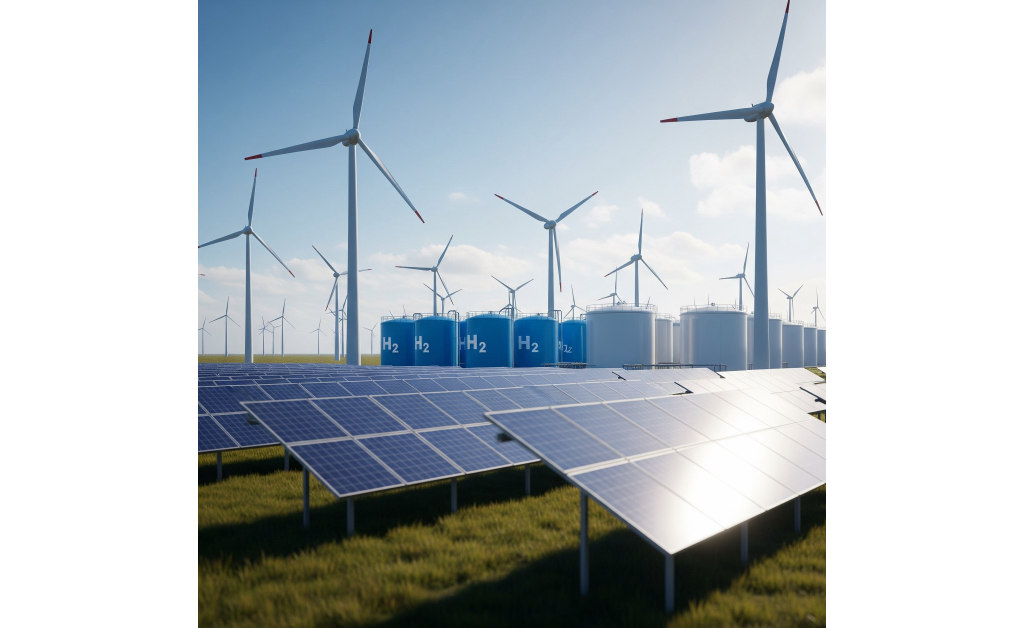India’s Energy Transition: The Role of Green Hydrogen
Green hydrogen is a revolutionary source of fuel that is driving the world towards greener energy as the world prepares to decarbonize its industries, grid energy sources, and transport systems. In simple terms, green hydrogen meaning refers to hydrogen produced using renewable energy sources such as solar, wind, and hydropower, ensuring zero carbon emissions.

Green hydrogen has a great potential in the case of India which is trying to achieve its ambitious net-zero emission goal by 2070. Dependance on the fossil fuels in the industrial processes, transport, and electricity production arouse exceptionally serious environmental and economic setbacks to the country. Green hydrogen in India is positioned as a game-changer, helping to reduce dependence on imported fossil fuels while advancing the country’s clean energy transition.
At the global level, countries, such as the United States, Germany, Japan, and Australia have intensively invested in green hydrogen technologies, policies, and infrastructure building. India, too, is taking substantial steps with its Green Hydrogen Policy India, aiming to become a major global hub for hydrogen production and exports. India has on the one hand sufficient amount of renewable energy resources and to add to that she also has a large-scale industrial infrastructure and therefore it stands naturally placed in taking a step forward in adoption of hydrogen energy.
Green Hydrogen Landscape in India
Current Production Capacity and Major Projects
India’s hydrogen production is still in its infancy stage but is growing fast. Large energy firms like Reliance Industries, Adani Group, Indian Oil Corporation, and NTPC are heavily investing in green hydrogen initiatives. Some of the key developments are:
- Reliance Industries $10 billion bet on the manufacture of green hydrogen and electrolyzer production.
- NTPC pilot project in Ladakh for the creation of India’s maiden green hydrogen-fueled public transport.
- Indian Oil Corporation hydrogen refueling stations to enable fuel cell-based mobility solutions.
- Adani Group’s proposal to set up one of the biggest green hydrogen manufacturing facilities with the world’s best technologists.
Government Policies and National Green Hydrogen Mission
Identifying the energy security potential of hydrogen, the government of India introduced the National Green Hydrogen Mission in 2023. The mission defines:
- Production incentives to expand domestic hydrogen production and reduce costs.
- Strategic investments in the production of electrolyzers to enhance local capacity.
- Infrastructure construction for hydrogen storage, transportation, and filling stations.
- Green hydrogen export policies to make India a worldwide exporter of green hydrogen.
India plans to achieve an output of 5 million metric tonnes of green hydrogen per year by 2030, funded by tax concessions, incentives, and regulatory conditions that attract the private sector.
Benchmarking Against Global Leaders
The U.S., Germany, and Japan: Lessons for India
India is lagging behind the world’s leaders in infrastructure development and technological advancements, despite having set ambitious goals for hydrogen production. Key findings from a comparison with top hydrogen economies are as follows:
United States
- The Biden Administration’s Hydrogen Shot initiative aims to reduce the cost of green hydrogen to $1 per kg by 2030.
- Large-scale investment in hydrogen hubs through the Infrastructure Investment and Jobs Act.
- Strong collaboration between the public and private sectors, including funding for R&D projects.
Germany
- Germany has committed over €9 billion to its National Hydrogen Strategy.
- Heavy focus on hydrogen-powered industrial clusters, with partnerships in the Middle East and Africa for hydrogen imports.
- Government-backed subsidies and research grants for green hydrogen innovation.
Japan
- A pioneer in hydrogen fuel cell technology, with Toyota and Honda leading in hydrogen-powered vehicles.
- Extensive refueling infrastructure and integration of hydrogen into the power grid.
- Strong public-private partnerships to accelerate hydrogen adoption in the transportation and industrial sectors.
Technological Advancements and Cost Comparisons
- India faces higher production costs, averaging $5-$6 per kg, compared to $3-$4 per kg in countries with advanced electrolyzer technology.
- Limited domestic electrolyzer manufacturing capabilities hinder cost reduction.
- Advancements in fuel cell technology and production efficiency are critical to making green hydrogen economically viable in India.
Policy, Investments, and Market Trends
Government Incentives and Private Sector Investments
To attract investments, the Indian government has rolled out several initiatives, including:
- Production-linked incentives (PLIs) to encourage electrolyzer manufacturing.
- Tax exemptions and subsidies for green hydrogen projects.
- Viability gap funding to support infrastructure development.
- Public-private partnerships (PPPs) to co-develop hydrogen energy solutions.
Private sector giants like Tata Power, JSW Energy, and Larsen & Toubro are also entering the green hydrogen market, signaling robust industry participation.
Future Potential in Decarbonizing Industries
Green hydrogen can upgrade components of a few of India’s carbon-intensive sectors:
- Steel Industry: Shifting coal-based direct reduction processes to hydrogen-based direct reduction processes.
- Transportation: Increased development of fuel cell electric vehicles (FCEVs) and hydrogen-fueled buses and trucks.
- Power Sector: Bouncing hydrogen into renewable energy storage and grid stabilization.
- Chemical Industry: Utilization of hydrogen as a feedstock to produce ammonia and methanol.
Challenges & Roadblocks
Infrastructure Gaps and Production Costs
One of the biggest hurdles for hydrogen production in India is the lack of infrastructure, including pipelines, refueling stations, and storage facilities. Moreover, the electrolyzer is very expensive and the cost of integrating renewable energy in the production process compounds this cost.
Policy Hurdles and Financial Constraints
- Uncertainty of regulation on safety, transportation and end-use application.
- The necessity of a transparent pricing system to render hydrogen commercially viable.
- Minimal spending on research and development of next-generation hydrogen.
Technological Innovation and Financial Support
In order to fulfill green hydrogen dreams, India needs more investment in research, innovation, and skill development. The cooperation with world technology giants, financial products, and related startups specializing in hydrogen can speed up the movement.
Conclusion
India is just on the edge of a green hydrogen revolution, backed by serious policy support and the interest of the private sector. The government’s Green Hydrogen Policy India and the National Green Hydrogen Mission are critical enablers in this journey. As the country is facing high production costs, infrastructure shortages, and challenges of policies, there is still a way to expedite a hydrogen economy in India by looking at global leaders.
Green hydrogen can play a central role in India to transform its energy system with the rise of investments, technology, and partnerships with other countries. As the adoption of hydrogen grows, it will have not only a decarbonization effect on major industries but it will also make India emerge as the world hydrogen powerhouse in the next few decades.
Frequently Asked Questions (FAQs)
Green hydrogen is hydrogen produced using renewable energy sources like solar and wind power, ensuring zero carbon emissions.
Green hydrogen can help India reduce its dependence on fossil fuels, cut carbon emissions, and support its clean energy transition.
It is an initiative by the Indian government to promote green hydrogen production, infrastructure development, and industrial adoption.
High production costs, lack of infrastructure, regulatory uncertainty, and limited technological capabilities.
India is still in the early stages compared to global leaders like the US, Germany, and Japan, which have more advanced hydrogen policies and technologies.












